Guide to Local SEO in 2023

Local SEO has been around for quite some time, but it’s now more important than ever, and rightly so. As much as ‘general’ SEO is great for your business, if you’re a small or medium business without a local SEO strategy, you’re losing out big time.
Do Local SEO like a PRO in 2023: Tips, Tricks And Actionable Advice to Rank Locally in Google
According to Google, local searches now account for more than 46 percent of all search queries. And mobile is at the forefront of this dramatic shift in search intent.
In fact, per HubSpot, 58 percent of mobile users search for local businesses daily, while a whopping 89 percent are searching at least once a month.
Even better, half of these mobile users who do a local search end up visiting a local business within 24 hours.
When you take all these stats into account, it is clear that marketers need to go above and beyond to rank for keywords and terms that are relevant to the purchase intent of users. And, of course, the fact that you need to market your business locally.
However, local SEO is much more than just content.
Similar to ‘general’ SEO, there are certain nuances of local SEO that marketers need to be aware of if they want to succeed in ranking their businesses locally. This guide touches on those topics.
Differences between ‘general’ SEO and local SEO
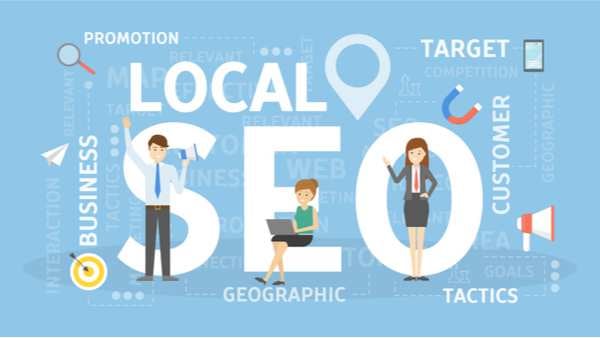
Let’s say, there is a nationwide chain of beauty shops. If that business has invested in SEO services, they will show up at the top of Google search results when users search for topics like, ‘How to take care of my skin.’
However, if they are not optimized from a local SEO standpoint, a user searching for a term like ‘beauty shops near me’ may never see the company in question on the first page of Google search results.
The difference between these two cases is the intent:
In the first case, a user wants information which may or may not result in them going to a specific location to buy a product. Perhaps they are looking for skincare tips, hacks, and whatnot. Purchase intent isn’t clear at all.
In the second case, however, the user intent to convert is more pronounced. They are looking for someone who can provide them a service in their city.
The latter case is the reason to have a very strong local SEO. It leads to actual conversions, which is, in this case, is patronage to a local beauty shop or salon.
What is SEO?
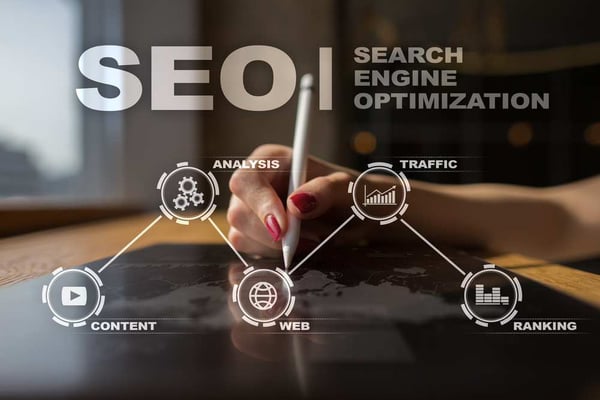
SEO is an acronym for Search Engine Optimization.
As we explained before, SEO refers to all the tactics, techniques and strategies you need to leverage to improve both the quality and quantity of traffic from organic search engine results pages (SERPs) to your website and landing pages. The ultimate goal of any SEO strategy is to rank first on page one of Google search results.
Why increase quality of traffic? You can pull in lots of traffic, but if they are the wrong audience, then they are of little or no value to your business. You want to attract web visitors who are actually interested in your services or products.
Why up the quantity of your traffic? Once you have relevant traffic coming to your website, the more traffic you get , the more sales you get.
SEO is all about organic results.
Google Ads do account for a significant percentage of search engine results, but you need to pay handsomely to get there. Organic traffic, on the other hand, is the holy grail of search because you do not have to pay a dime for their click-throughs to your website. We’ve actually created an article on the main differences between SEO and SEM which can be read here.
What is Local SEO?
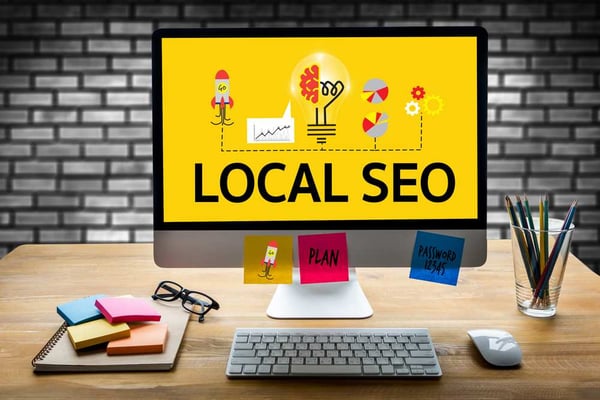
Local SEO is the practice of optimizing your business website and online profiles to show up in local search results. It is one of the most effective ways to market your local business online.
Local SEO is all about getting your website ranked higher on local SERPs. Simply put, Local SEO gives you an opportunity to promote your business to local users who are already looking for services or products you offer closest to them.
Local SEO requires you to optimize for your address, city name and other locally-identifying details. In a nutshell: you have to optimize for local search so that customers know your location, business hours and are able to find you in real life (if need be).
Why is Local SEO Important for a Business?
In the digital age, small and medium-sized businesses are struggling to find customers online who are looking for the products and services they offer in their geographical area.
Enter local SEO. This methodology helps you provide potential customers with local information wherever they are and whenever they want it. As such, it matters because a big percentage of local customers search for a business before engaging with it.
This becomes even more prominent in the local context.
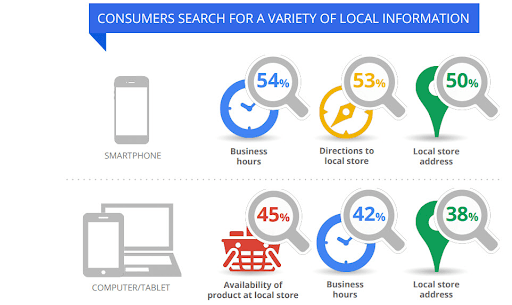
Smartphone users are using their devices to search for a wide range of local info.
According to a Forbes survey, 95 percent of smartphone users have used their devices to conduct a local search. Of these searches, 59 percent led to a foot traffic to local a business, while 61 percent resulted in a call to a local business.
What kind of local searches are smartphone users performing? Half of them search for a local store address, 53 percent for directions to local stores, and 54 percent for business hours.
Tablets/computers have also gone “local.” 42 percent of tablet/PC users search for business hours, 45 percent of availability of certain products/services they are interested in at a local store, and 38 percent for the address of local store.
Drive foot traffic even without having a website. You see, local SEO helps you drive more traffic to your website through local SERPs. In fact, it can make your business stand out in local searches even if you don’t have an actual website.
Local SEO helps your business get discovered, found and verified. According to HubSpot, 71 percent of online users check out the location of a local business before they visit it for the first time. In other words, the higher your local search ranking, the more foot traffic you will get.which translates into more sales and more profitability.
Gain an added edge over your competition. Local SEO helps boost both your local and online visibility. And by optimizing for local search, you will make it effortlessly easy for potential customers to find you earlier than your competition.
When all’s said and done, if you don’t have proactive local SEO strategies, you may end up losing potential customers to your local rivals.
They’ll close their local sales quicker, slowing your conversion rates down to a screech.
Just imagine how appearing in local searches will help you pull in new customers who are searching for what you offer. They could be residents looking for new products, tourists passing through your town, or newcomers to your local area.
What’s the Local SEO Relation with Voice Search?

Okay, Google …
According to comScore, 50 percent of all searches will be voice by 2020. Today, billions of voice searches are performed every month, 40 percent of which have a local intent, as per a Google-Nielsen study.
As it is evident from the above study and many others conducted thereafter, local SEO have to keep voice search in the front burner. In other words, you have to optimize for voice as part of your local SEO strategy.
We, as consumers, are hardwired to gravitate towards convenience, something which voice search is providing us in abundance. Given that smart-speaker ownership is expected to leapfrog from today’s 42 percent to 55 percent by 2022, your local search strategy has to be in line with this projected growth.
Voice searches are becoming more and more reliable. In 2013, Google voice search was slightly below 80 percent accurate, now the word processing accuracy has gone beyond 95 percent. That means that local searches conducted via voice are becoming increasingly precise.
The proliferation of virtual assistants is the key driver for voice search. Digital assistants like Microsoft Cortana, Apple Siri, Amazon Alexa, and Google Assistant are now ubiquitous. And they are all optimized to deliver incredibly accurate local searches. If you are interested in learning more about Voice Search, check out our comprehensive guide on the topic.
Google Local Pack
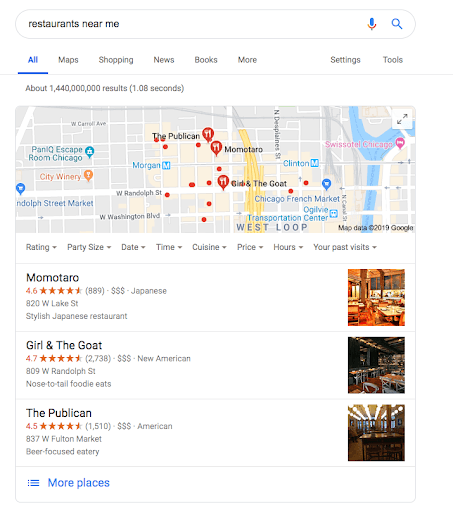
Local SEO has become almost synonymous with Google Local Pack. but, what is it, and why does it matter to your local search strategy?
Even if you don’t know what Google Local Pack is, the chances are almost 100 percent that you have come across it and even interact with it.
Google Local Pack is what the doctor prescribed when it comes to achieving your local business success.
Also known as Snack Pack, Local 3-Pack or Map Pack, Google Local Pack is a map-like feature that Google uses to show the 3 topmost results for local search results pages (SERPs).
In layman terms, this is a method that Google employs to rank a local search query as well as display the names, phone and address of the 3 most relevant results (previously these were 7 but they have been reduced to align with mobile browsing).
Since Google moved from a seven-pack to a 3-pack setup, the competition to show up in this list has become cut-throat. As such, it is incredibly crucial for businesses to try and show up here as the chances of converting customers becomes much higher.
If a three-pack is too crowded, it is about to get even worse. Just recently, search engine giant has been experimenting with a two-organic local listing with a paid ad taking up the third spot. While this isn’t official, local SEOs are urged to brace themselves for even tougher competition.
Even still, Google Local 3-Pack is increasingly becoming pervasive. In fact, it appears in over 30 percent of all 1st page SERPs, making it the most displayed search results feature, trailed by snippets.
If you appear in the Google Local Pack, your business hours, review rate and NAP (name, address, phone) and call button will be availed to the user. It’s for this reason that you need to optimize properly for all of these elements.
Facts and Figures about Local SEO
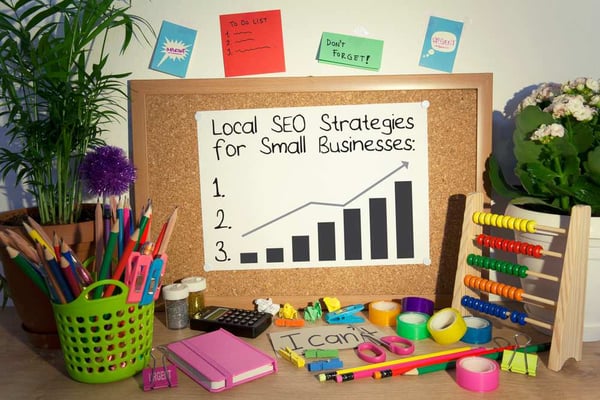
If you are still unsure whether to do local SEO or not, here are some key stats that are poised to convince you.
What do users do after landing on a local search? As per Moz use case study, 29 percent clicked through to a website from organic listings; 8 percent decided to click on “more local results”; 19 percent opted for paid local search results, and 44 percent clicked a result in the Local 3-Pack.
If you want to get found easily in local searches, your online presence and mobile website are crucial.
61 percent of mobile users say they won't go back to a mobile website that they had difficulties loading, browsing or accessing. 57 percent say they don’t recommend such badly designed or inaccessible mobile site to others. 40 percent of disgruntled mobile users end up visiting competitor websites.
Mobile site loading speeds are important. Mobile sites that load in 5 seconds or sooner enjoy 70 percent longer web sessions and 25 percent more ad visibility. 91 percent of mobile users want fast, convenient access to content. We’ve covered this factor and many more in our comprehensive guide to technical SEO available here.
User experience is everything when it comes to local SEO. 7 out of 10 resort to a different website if it is inaccessible or takes too long to load. 69 percent of local searchers are likely to make a purchase from an informative and easy to use website.
Local searchers are looking for instant, accurate results. If you display incorrect info, you risk losing trust of 80 percent of consumers, according to BrightLocal. Even worse, 93 percent of consumers are confused and frustrated by incorrect info.
Social media also plays a key role. 69 percent of users (including local searchers) use social media in the US. 59 percent of consumers seek purchase ideas and inspiration from social media platforms.
Local SEO Ranking Factors
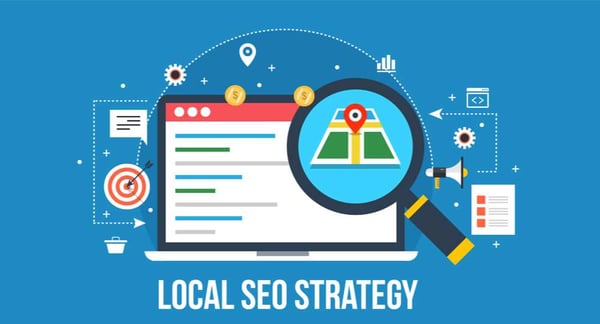
When it comes to processing local search queries, Google takes three key aspects into consideration:
-
Distance: How close is your business located in proximity to where the search is being performed? If your business is the closest (and of course relevant), it will get a good local search ranking (Local Pack ranking).
-
Relevance: Google itself has iterated many times on their search result algorithms to ensure that they show users the most relevant results for a search query. Relevance is also key to local search ranking. Is your business, products or services the relevant result for the search query? Does what you offer match what the user is searching for?
-
Prominence: This boils down to your credibility and how well your business is known locally. If you are perceived credible and trustworthy in the eyes of Google (and users), you’ll get a good local ranking.
While the three aspects play a huge role, here are some of the most important factors that contribute to local SEO:
(a) Locations
Again, distance is a key local SEO ranking factor. That’s why you need to keep your address updated and ensure it is shared with Google in the right format. There are two types of addresses that Google is interested in when ranking for a local audience: structured and unstructured.
A structured address is often displayed in NAPW (Name, Address, Phone, and Website) format. So, if you haven’t already done, go ahead and fill out the application in Google My Business. You can expect to get the verification code sent to your physical address by post within three to five days. All you have to do is enter the code and get your business address verified.
This is especially important for multi-location businesses. Ensure that the addresses for all of your locations are clearly indicated so they can rank for particular geographical regions.
(b) My Business Listing
Once your business address has been verified and registered, you will have to enter other key information to complete Your Google ‘My Business’ listing. It is crucial that you list the business properly on Google, otherwise you will give your competitors the upper hand in local search.
If a piece of information about your business will help boost your local search visibility, don’t hesitate to add it to your My Business listing. More crucially, you need to go through instructions by Google on how to write and present the listing information.
(c) Local Directories and Social Media
There’s a good reason Google is fond of local directories when it comes to search rankings. These directories usually present business addresses and other info in a structured format. So, ensure to list your business in directory websites like Foursquare, Yellowpages, Yelp, etc, and ensure that the latest details about your location are there.
(d) Reviews
Reviews are displayed (if available) in the Google Local Pack alongside your business contact information. These reviews are another important component which allows Google to know how trustworthy a business is. After all, consumers are keen on reading reviews before making any purchase decisions.
97 percent of online users read local business reviews, according to a survey carried out by Bright Local. To that end, reviews make a big role in consumer decisions and contribute greatly to your online visibility and trustworthiness. As such, it is important to keep track of complaints and reviews - as well as respond timely to them.
(e) Content
To ensure that your website and content are highly relevant to local search queries, you have to optimize all your pages, blogs, and other pieces of content to cater to local users and their needs.
Oftentimes content optimization means that you have to add location-specific modifiers to your semantic core. For Google to associate your website and business with a given geographical location, your content should incorporate the city’s name, the state, region, and the district (in some situations).
When optimizing your content for local search, you should also keep technical SEO elements in mind. Your site’s local SEO health includes technical factors like security, mobile-friendliness, loading speeds, crawlability, and much more. If you neglected these technical SEO problems, your local pack ranking will suffer.
You shouldn’t forget about link authority, which takes us to the next point.
(f) Local Backlinking
It’s no secret that backlinking and authority building is vital for overall SEO. In fact, you can build authoritative links using the same ideas as overall SEO. However, in this case, you should try to get backlinks from other local businesses. By backlinking from other local businesses, you will increase your relevance in the eyes of Google for local search results.
Using Local Schema for Business, Products, and Services
Schema has gained traction with SEO specialists in the past handful of years as a genuine way of making it to the rich snippets and Google answer boxes in the so-called position zero of SERPs. The same also goes for local SEO - you need to apply local schema markup.
Schema markup is a line or several lines of code that you can leverage to markup several different elements of your site to help Google understand it more accurately. When you tell Google what your pages are all about using schema markup, you will have preferential treatment when it comes to search rankings.
This is a gem for local SEO professionals. And it’s easy to do this. Just add local business schema markup to your site and every page to optimize them for local SEO. If you don’t apply proper local schema markups, getting into Snack Pack will become an uphill task.
The good news is that you can add markup code for every page, the entire website, products and services pages, too. By applying this nifty codes, you will indicate to Google exactly what your address is, your business name, office hours, telephone number, and other details that will help you gain a higher local search ranking.
Steps to Adding Local Business Schema Markup
Step 1. Display your NAPW Properly
Right off the bat, it’s worth mentioning that you should never display your business name, address, phone and website URL (NAPW) in an image format. While there’s technically no problem with that, this will present a huge problem to web crawlers (what Google uses to rank your site).
Instead, you should list your NAPW details in an easy to read and crawler-friendly HTML text format.
Here’s an example from Digital Authority Partners, a digital experience company based in Chicago:
1212, W Merchandise Mart Plaza
Suite 1212
Chicago, IL
(312) 600-5433
You will find their business name, phone number, physical address, and more when you scroll down to the bottom of each page. This is exactly where your NAP information should be displayed.
Step 2. Add the Actual Local Business Schema.org Markup to your Website (and Pages)
You need the markup code which you can get from schema.org. The next step is as easy as getting to plug in and tag your site data to Structured Data Markup Helper. This is a handy tool by Google.
Key in the website URL and click “start tagging. It will warn you if you didn’t add the markup code properly. Good thing, you can download your local schema markup code and take it for test-drive Google’s Structured Data Testing Tool.
A couple of tips to keep on hand:
- Your local business schema structured data should be spam-free.
- It should tell Google exactly what your website or business is about. If your markup data is deemed to be spammy you risk getting penalized or de-ranked by Google.
Ensure that your schema markup best matches the user intent. It’s all about meeting Google’s instructions and guidelines.
3) Claim your Google My Business (GMB) Listing
One of the most effective ways to get your business into Local 3-Pack is to claim, verify and optimize your local business’ Google My Business listing. It’s also crucial for appearing higher in local SERP results.
The beauty of GMB is that it’s absolutely free and can deliver highly targeted traffic both to your physical store and online resources like your website, blog, social media, etc.
More importantly, the Knowledge Graph is another incredible Google tool that uses verified GMB data to help process locals search queries and rank local businesses. So, how do you claim and optimize your Google My Business listing?
Here are some tips that will come in handy when optimizing your GMB listing:
Use proper keywords to optimize your GMB content. Sprinkle primary keywords when you are filling out your business content because this contributes around 20 percent towards your Local Pack ranking. The better optimized your content, the higher your chances of getting into Local 3-Pack.
Your office/operating hours should be razor-accurate. Your business hours should be entered truthfully because any complaint will spell doom to your ambition to join the Local Pack in your geographical area of service. Make sure to update the hours accordingly whenever they change. Google provides you with the chance to personalize your business operating hours for special events like Holidays, etc.
Include Images. We all love visually-stunning images. So, add as many photos to your GMB listing as possible. According to Google, business listings with photos get 35 percent more click-throughs to their business sites and 42 percent more Google Maps’ requests for driving directions.
Don’t forget to include logo photos, cover photos and other good-looking photos that will spotlight your business. They should be 10KB-5MB in size, 720x720 minimum resolution, well-lit and focused. Stick with PNG and JPEG formats.
Make sure the listing is complete and accurate. GMB listings that provide accurate and detailed info will be favored in local search ranking. After all, relevance is one of the most important local SEO ranking factors. The user should never guess or assume some of your business details; the listing should communicate everything clearly and completely.
In short, ensure your GMB listing tells the users effectively what your business name is, where it is located, what it does, and how they can acquire your products/services. They should find this info without any hassle or additional steps.
Monitor and respond to reviews/complaints from customers. Use review sites and tools to interact with customers. Use these chances to provider customers more value and get feedback on what to improve. After all, positive reviews are going to count towards increasing your business visibility and credibility in local search.
4) Adding Business to Local Directories and Social Platforms
Citation building and listing in major local business directories are a good strategy for optimizing your site for local search. Today, there are hundreds of extensive business directories, with Yellowpages, Google My Business, LinkedIn, Yelp, Whitepages, Manta, Local.com, Facebook, CitySearch, and Yahoo Local being to the top ones.
When adding your listing to these directories and social media platforms, it pays to ensure that each and every entry is exact to the others. They should paint the same picture of your business across all directories and social sites. As such, you should keep the same representation and format, making sure that they all mirror your GMB listing.
It is crucial that you should opt for the right director or platform. It is not prudent to spend oodles of man hours and money trying to list your business on every possible directory. Instead, find and list on only those platforms that you think will propel your credibility and help you score business.
5) Make Reviews and Reputation Building Important
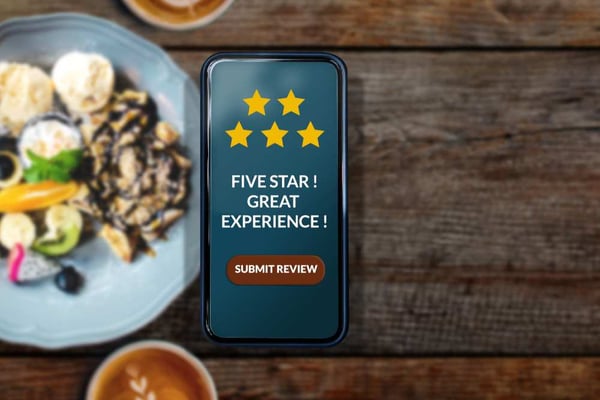
As if that isn’t sweet to businesses enough, 97 percent of consumers admit that user reviews play an important role in their purchase decisions. But, more importantly, Google has confirmed that reviews (and responding to them) can improve your local SEO.
You see, as your local business grows, it is paramount that you seek validation. That’s where reviews come into the picture. They are votes of validation for your local business. If you have raving reviews, your products and services are likely to be top-notch in the eyes of users.
Google considers your reviews and rating across several sites like Facebook, Yelp and Google own to deliver better local search results. So, if you want to appear in the Local Pack and rank higher in local SERPs, you need to respond to both positive and negative reviews. It’s a great way to get in Google’s good books.
Tips for Responding to Good Reviews
Positive reviews are a godsend, but only if you use them to your advantage. Here’s how to respond to them:
Keep it personal and be specific. Generic responses are a huge turn-off to some users. Even if you want to use generic answers, be sure to touch on something personal and specific to the review/case in question. The customer will appreciate your personal touch.
Say thank you. It can go a long way.
Give them an incentive. Show customers that you appreciate their business and review by offering discounts, samples and other incentives to come back or refer a friend.
Tips for Responding to Bad Reviews
This is where how you respond will make a big difference
Encourage the user to take the convo offline. Simply ask them to contact customer service and ensure to go above and beyond to make sure the case is addressed professionally and to the customer’s satisfaction.
Give a sincere apology and say thank you to the customer for the feedback.
Respond in an appropriate manner. At no time should you blame, accuse or abuse the customer. Don’t even argue. It’s all about the customer.
Keep it sweet and short. The trick is to ensure that review is dealt with quickly, politely and professionally.
Content Optimized for Local Searches
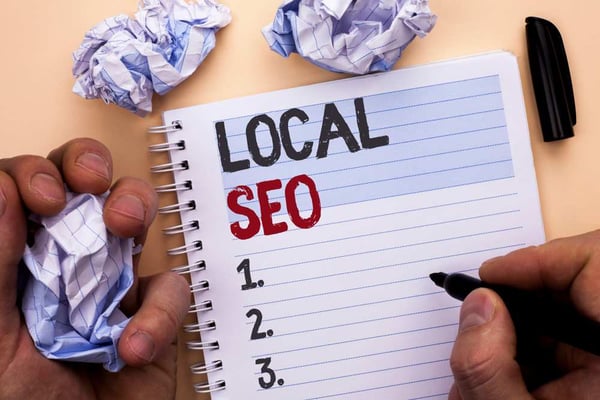
Content is a super effective way to rank for less competitive, local keywords.
Before producing localized content for your area, conduct some research to identify your target audience. The best way to do this is by taking advantage of the fact that you are a local business. You might also want to interview customers face-to-face.
Content ideas include:
Topics, subjects or questions that your customers ask frequently. This applies to both offline and online questions and customer queries.
Google trends. This is an amazing free tool that tells you the search volumes for keywords that you are interested in optimizing.
Local information. What is so unique and special about the geographical area that your business serves. Talk about local happenings, attractions, and highlight issues that are facing your specific service area.
Previous case studies. Provide users with valuable insights and information from your past case studies. This is especially important to local businesses in the B2B niche.
Customer feedback, transcriptions and interviews. Conduct both one-on-one and online interviews. You can upload the actual video of the interview or generate a transcript.
City-focused, state, regional, and even district landing pages. This should help spotlight your products, challenges and other pieces of info related to that particular region.
FAQ pages. Ensure they are rich, vibrant and contain relevant/useful information. You will use these FAQ pages to provide value as well as optimize for local search. Talk about pulling double duty!
Organize local events. You can even partner with local businesses and event organizers to bring consumers closer to you.
Conclusion
Local SEO is more important than ever. It helps your business found in local SERPs and make it to Google Local Pack.
Like the overall SEO strategy, you need to keep analyzing and optimizing the local SEO strategy to become relevant to your local customers. Make sure that your local listing details are accurate and up to date, continuously refresh your content to reflect user intent, and don’t forget to respond to reviews politely and quickly.
The immediate benefits are obvious, including being found by local users, greater chance of converting them. However, there are larger implications as well.
For instance, voice search is dependent to a great degree on local SEO to produce accurate and highly relevant results. With a large number of users moving towards voice search, it becomes all the more important to have a robust local SEO strategy.








